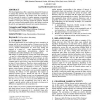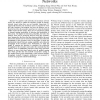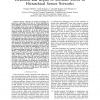97 search results - page 15 / 20 » IP covert timing channels: design and detection |
WWW
2005
ACM
14 years 8 months ago
2005
ACM
Web based applications offer a mainstream channel for businesses to manage their activities. We model such business activity in a grammar-based framework. The Backus Naur form not...
PIMRC
2008
IEEE
14 years 1 months ago
2008
IEEE
—One of the major challenges in designing cellular Cognitive Radio (CR) networks is the avoidance of Secondary User (SU) interference to so called Primary Users (PUs) operating i...
ICC
2007
IEEE
14 years 1 months ago
2007
IEEE
— In cognitive radio networks, the secondary network (users) are allowed to utilize the frequency bands of primary network (users) when they are not currently being used. To supp...
SUTC
2006
IEEE
14 years 1 months ago
2006
IEEE
Abstract— Sensor networks are being increasingly deployed for collecting critical data in various applications. Once deployed, a sensor network may experience faults at the indiv...
CN
2007
13 years 7 months ago
2007
Worms are self-replicating malicious programs that represent a major security threat for the Internet, as they can infect and damage a large number of vulnerable hosts at timescal...



